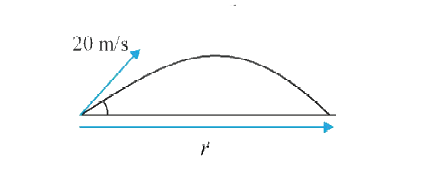A projectile is fired form the top of a 40 m high cliff with an initial speed of 50 m/s at an unknown angle. Find its speed when it hits the ground.
To find the speed of the projectile when it hits the ground, we can use the work-energy theorem. Here’s a step-by-step solution:
Step 1: Understand the Problem
We have a projectile fired from the top of a 40 m high cliff with an initial speed of 50 m/s at an unknown angle. We need to find the speed at which it hits the ground.
Step 2: Apply the Work-Energy Theorem
According to the work-energy theorem:
Work done by all forces=Change in kinetic energy
The only force doing work in this case is gravity.
Step 3: Write the Equation
The work done by gravity can be expressed as:
W=mgh
where:
- m is the mass of the projectile,
- g is the acceleration due to gravity (approximately 10m/s2),
- h is the height of the cliff (40 m).
The change in kinetic energy can be expressed as:
ΔKE=KEfinal−KEinitial
KEinitial=12mu2
where u is the initial speed (50 m/s).
Step 4: Set Up the Equation
From the work-energy theorem:
mgh=KEfinal−KEinitial
Substituting the expressions for kinetic energy:
mgh=KEfinal−12mu2
Step 5: Rearranging the Equation
Rearranging gives us:
KEfinal=mgh+12mu2
Step 6: Cancel the Mass
Since mass m appears in all terms, we can cancel it out:
KEfinal=gh+12u2
Step 7: Substitute Known Values
Now, substituting the known values:
- g=10m/s2
- h=40m
- u=50m/s
The equation becomes:
KEfinal=10×40+12×502
Step 8: Calculate
Calculating each term:
- gh=10×40=400
- 12×502=12×2500=1250
So:
KEfinal=400+1250=1650
Step 9: Find the Final Speed
The final kinetic energy can also be expressed as:
KEfinal=12mv2
Setting this equal to our calculated value:
12mv2=1650
Step 10: Solve for v
Since m cancels out, we can solve for v:
v2=3300
v=√3300≈57.45m/s
Final Answer
The speed of the projectile when it hits the ground is approximately 57.45 m/s.
---
We have a projectile fired from the top of a 40 m high cliff with an initial speed of 50 m/s at an unknown angle. We need to find the speed at which it hits the ground.
According to the work-energy theorem:
Work done by all forces=Change in kinetic energy
The work done by gravity can be expressed as:
W=mgh
where:
- m is the mass of the projectile,
- g is the acceleration due to gravity (approximately 10m/s2),
- h is the height of the cliff (40 m).
ΔKE=KEfinal−KEinitial
KEinitial=12mu2
where u is the initial speed (50 m/s).
From the work-energy theorem:
mgh=KEfinal−KEinitial
Substituting the expressions for kinetic energy:
mgh=KEfinal−12mu2
Rearranging gives us:
KEfinal=mgh+12mu2
Since mass m appears in all terms, we can cancel it out:
KEfinal=gh+12u2
Now, substituting the known values:
- g=10m/s2
- h=40m
- u=50m/s
KEfinal=10×40+12×502
Calculating each term:
- gh=10×40=400
- 12×502=12×2500=1250
KEfinal=400+1250=1650
The final kinetic energy can also be expressed as:
KEfinal=12mv2
Setting this equal to our calculated value:
12mv2=1650
Since m cancels out, we can solve for v:
v2=3300
v=√3300≈57.45m/s
The speed of the projectile when it hits the ground is approximately 57.45 m/s.
Topper's Solved these Questions
- BOOK - HC VERMA ENGLISHCHAPTER - WORK AND ENERGYEXERCISE - Question for Short Answer16videos
WORK AND ENERGY
- BOOK - HC VERMA ENGLISHCHAPTER - WORK AND ENERGYEXERCISE - Objective -28videos
WORK AND ENERGY
- BOOK - HC VERMA ENGLISHCHAPTER - WAVE MOTION AND WAVES ON A STRINGEXERCISE - Question for short Answer7videos
WAVE MOTION AND WAVES ON A STRING
Similar Questions
A pebbel is thrown horizantally from the top of a 20 m high tower with an initial velocity of 10m/s.The air drag is negligible . The speed of the peble when it is at the same distance from top as well as base of the tower (g=10m/s2)
View SolutionA ball is thrown upwards from the top of a tower 40m high with a velocity of 10m/s. Find the time when it strikes the ground. Take g=10m/s2.
View SolutionA ball is thrown upwards from the top of a tower 40m high with a velocity of 10m/s. Find the time when it strikes the ground. Take g=10m/s2.
View SolutionA projectile is fired vertically from the earth's surface with an initial speed of 10km/s. Neglecting air drag, how high above the surface of earth will it go?
View SolutionOne stone is projected horizontally from a 20m high cliff with an initial speed of 10ms−1. A second stone is simultaneously dropped from that cliff. Which of the following is true?
View SolutionA ball is projected horizontally from the top of a building 19.6 m high. If the line joining the point of projection to the point where it hits the ground makes an angle of 45∘ to the horizontal, the initial velocity of the ball is
View SolutionA ball is projected downward from the top of a cliff of height h with an initial speed v.Another ball is simultaneously projected vertically up from the bottommost of the cliff with the same speed.When do they meet?
View SolutionA projectile is fired from a gun at an angle of 45∘ with the horizontal and with a speed of 20m/s relative to ground. At the highest point in its flight the projectile explodes into two fragments of equal masses. One fragement, whose initial speed is zero falls vertically. How far from the gun does the other fragment land, assuming a level terrain? Take g=10m/s2?
View SolutionA projectile projected with initial velocity 20m/s and at and angle of 30∘ from horizontal. Find the total work done when it will hit the ground.
 View Solution
View SolutionA ball is thrown from the top of a building 45m high with a speed 20ms−1 above the horizontal at an angle of 30∘. Find
(a) The time taken by the ball to reach the ground.
(b) The speed of ball just before it touches the ground.View Solution

